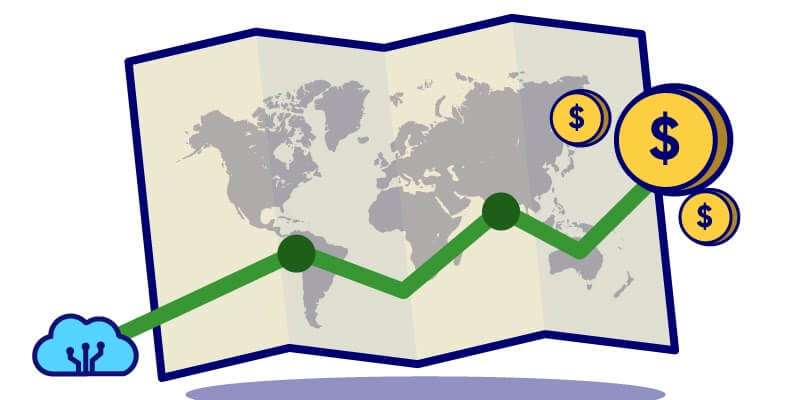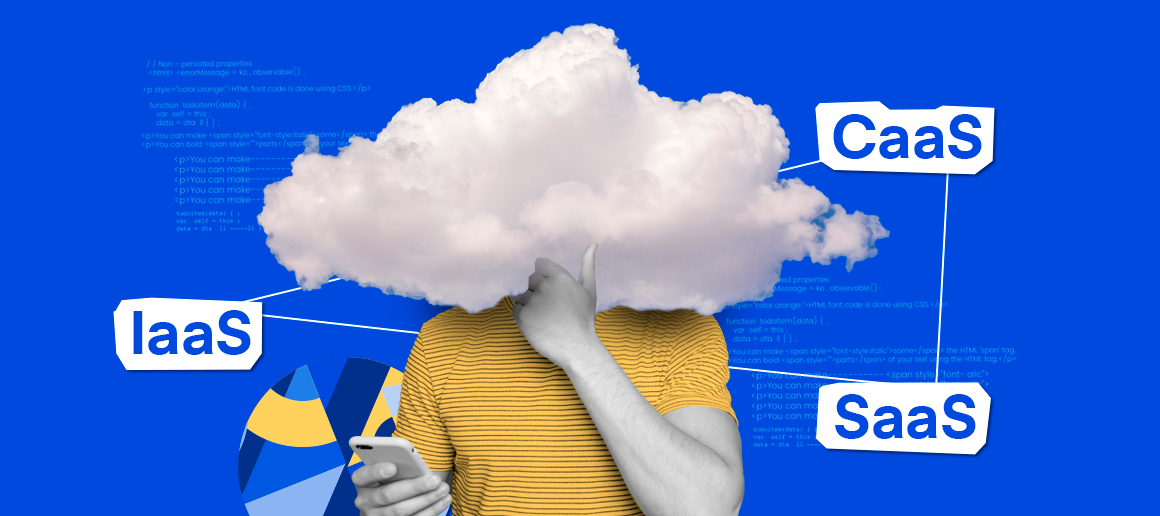Cloud technology might at first seem like some type of magic on the same trajectory as The Force from Star Wars. In actuality, the true capacity of cloud technology isn’t far from magic.
Considering that the cloud computing industry is valued at $738.2 billion in 2025, and expected to reach $1.6 trillion by the end of 2030, whatever this industry is, it’s certainly worth the investment.
For many businesses, the “cloud” still feels abstract. What is cloud technology? How does it actually work? What makes it so transformative? How can your organization use it safely and cost-effectively?
For startups and enterprises alike, understanding the cloud is essential for speed, scalability, and resilience.
Our expert cloud developers have helped a variety of companies make use of this technology successfully, through cost-effective hiring like outsourcing and staff augmentation.
Let’s look at everything you need to know.
Are you ready to start your development project?
We have the developers you need to take your development project in the right direction.
Companies are proven to grow their business faster with Trio.
What Is Cloud Technology?
Cloud computing encompasses a broad set of technologies that allow individuals and businesses to access computing resources such as servers, databases, networking, and software over the internet instead of maintaining physical infrastructure on-site.
In simpler terms, it’s the on-demand delivery of IT resources via the internet, typically on a pay-as-you-go basis.
Rather than buying and maintaining expensive hardware, you rent the computing power and storage you need from a cloud provider, scaling up or down whenever your business requires.
There are several popular models of cloud services, each designed to handle different layers of computing needs:
Infrastructure as a Service (IaaS), Platform as a Service (PaaS), Serverless Computing, and Software as a Service (SaaS).
These models determine how much control you retain and how much your provider manages for you.
Beyond service models, cloud computing also comes in several deployment types: Public, Private, Hybrid, and Multicloud. Each option has its own balance of flexibility, security, and cost efficiency.
Public clouds, like Amazon Web Services (AWS), Microsoft Azure, or Google Cloud Platform (GCP), provide shared infrastructure available to anyone.
Private clouds are dedicated environments for one organization, often used for compliance-heavy industries.
Hybrid and multicloud setups combine both, allowing companies to mix and match providers or integrate on-premise systems with cloud resources.

Cloud Service Models
Let’s break down each one of the categories mentioned above: Infrastructure as a Service (IaaS), Platform as a Service (PaaS), Serverless Computing, and Software as a Service (SaaS).
IaaS
IaaS is one of the root forms of cloud computing. This is because IaaS provides network infrastructure like servers and storage. Businesses like yours can avoid investing in on-site resources and outsource this need to an IaaS provider.
Amazon Web Services (AWS) is likely the most pervasive example of IaaS. While it’s likely more people are familiar with the online shopping website, AWS is a cloud platform hosting data centers globally that powers much of the internet.
Jeff Bezos compares AWS to a utility company. In the early 1900s, a factory needing electricity would need to build its own power plant. Of course, this was until electric companies made it possible for others to buy electricity as a public utility.
Similarly, AWS serves as a storage space for more than a third of the cloud market. For small and medium-sized businesses (SMBs), especially, this can be a practical way of reducing startup costs.
PaaS
PaaS provides a complete development and deployment environment in the cloud, including operating systems, databases, middleware, and runtime tools.
Developers can focus on writing code rather than configuring or maintaining infrastructure.
For example, Google App Engine and Microsoft Azure App Service let you deploy applications directly, handling updates, patching, and scaling automatically.
This makes PaaS ideal for teams that want to accelerate development cycles and standardize deployment workflows.
Serverless Computing
Serverless computing takes the PaaS model one step further.
With serverless, you write and deploy code, and the cloud provider automatically provisions resources when the code runs. You pay only for the computing time you use.
Popular examples include AWS Lambda, Azure Functions, and Google Cloud Functions.
This approach eliminates the need to manage servers or capacity planning, allowing developers to focus purely on business logic and innovation.
SaaS
With SaaS, businesses can access software on a subscription basis.
SaaS providers carry the burden of maintaining and storing servers, databases, and the code that makes up the application. All you need is an internet connection. Some salient examples of SaaS might be Microsoft 365 or Dropbox.
Microsoft 365 lends you all the products of the Microsoft Office Suite that are often installed on one’s computer. With Microsoft 365, it can be utilized from your web browser, with no installation required.
Dropbox is a storage service where you can save documents, pictures, and videos online. The advantage gained is that if you lose media on your local device, you will always have a backup online, so long as you have an internet connection.
Cloud Development Models
Different organizations have different security, scalability, and compliance needs, which is why the cloud can be deployed in several distinct ways.
The four primary deployment models are Public, Private, Hybrid, and Multicloud.
Each offers a unique balance of control, flexibility, and cost efficiency.
Public Cloud
A public cloud is the most common deployment model, where computing resources are shared among multiple users via the internet.
The infrastructure is owned and operated by a third-party cloud provider such as Amazon Web Services (AWS), Microsoft Azure, or Google Cloud Platform (GCP). We’ve already mentioned these above.
Because the provider manages everything from hardware maintenance to updates, you gain scalability, global reach, and reduced costs.
Public clouds are ideal for startups and growing businesses that value agility and don’t need to manage their own hardware.
Private Cloud
A private cloud is a dedicated environment used exclusively by one organization.
It can be hosted on-premises or managed by a third-party provider, but remains isolated from other users.
Private clouds offer enhanced security, control, and customization, making them suitable for industries like finance, healthcare, and government, where compliance is critical.
The trade-off is higher cost and reduced flexibility compared to the public cloud.
Hybrid Cloud
A hybrid cloud blends public and private environments, allowing data and applications to move between them.
This setup gives organizations the flexibility to keep sensitive workloads in a private cloud while leveraging the scalability and innovation of public cloud services.
For example, a business might store confidential customer data in a private cloud but use AWS or Azure for high-performance analytics or seasonal workloads.
Hybrid models are increasingly popular for companies transitioning gradually from legacy systems to modern infrastructure.
Multicloud
A multicloud approach uses multiple cloud providers to avoid vendor lock-in and optimize performance.
This strategy helps organizations choose best-of-breed services for each need (for example, AI tools from Google Cloud, storage from AWS, and productivity tools from Microsoft 365).
Multicloud deployments also improve resilience: if one provider experiences downtime, critical services can continue operating elsewhere.
How Does Cloud Technology Work?
Perhaps the simplest way to understand how cloud computing works is to envision computer systems as being composed of two categories: front-end and back-end. These two ends are connected via a network, largely the internet.
The front end involves everything the user interacts with directly, including websites, applications, or interfaces that display and collect data.
For example, what you see on this page is the front end, designed through web technologies that make the experience intuitive and responsive.
The back end, on the other hand, contains the servers, databases, and infrastructure that process, store, and manage that data.
It’s where the heavy lifting happens, like calculations, storage, and security, all of which live behind the scenes.
When cloud computing enters the picture, the back end no longer needs to live in a company’s physical data center. Instead, these processes take place on remote servers hosted by a cloud provider, connected to users through secure internet protocols.
This shift from local infrastructure to the cloud means computing resources can be pooled, virtualized, and allocated dynamically as demand changes.
If a website suddenly sees a surge in traffic, for example, the cloud can automatically scale up to handle it, then scale back down when demand drops, keeping costs efficient.
Behind the scenes, cloud providers manage a global network of servers, known as data centers, often spread across regions to ensure redundancy, uptime, and low latency.
Your files, applications, and data aren’t stored in one machine but distributed across multiple servers for speed, security, and resilience.
6 Benefits of Cloud Computing
The simplicity and accessibility of cloud technology encourage its use in both the public and private sectors. Let’s look at nine key ways in which cloud technology is changing the economy.

1. Cost Efficiency
Cloud computing helps businesses save on infrastructure costs by offering resources on a pay-as-you-go basis.
There’s no need to purchase physical servers or pay for unused capacity. You pay only for what you use.
Compared to hardware investments that require significant upfront capital, cloud-based systems reduce total cost of ownership (TCO) and free up budgets for innovation.
2. Speed and Agility
Cloud infrastructure can be deployed in minutes rather than weeks or months.
Teams can test, build, and launch products faster, helping businesses respond more quickly to market changes.
This agility makes the cloud ideal for startups, agile software teams, and enterprises seeking to accelerate time-to-market.
3. Global Reach
Cloud providers operate massive data centers worldwide.
This global footprint allows companies to deliver consistent performance and low latency to users across continents.
Whether you’re serving customers in São Paulo or Singapore, the cloud enables your business to scale internationally without building local infrastructure.
4. Elastic Scalability
The capacity of the cloud is virtually unlimited.
You can scale resources up or down automatically to meet real-time demand, whether that’s a traffic surge during peak season or a quiet off-period.
This elasticity ensures you always have the right resources at the right cost.
5. Reliability and Business Continuity
Because cloud resources are distributed across multiple data centers, the risk of downtime is dramatically reduced.
Built-in redundancy and backup systems ensure high availability, even during maintenance or regional outages.
This makes disaster recovery faster, easier, and far more cost-effective than traditional approaches.
6. Security and Compliance
Modern cloud providers use advanced encryption, access control, and continuous monitoring to protect data.
Many are also compliant with global standards such as ISO 27001, GDPR, and SOC 2.
For most organizations, data stored in the cloud is actually safer than on a local server, thanks to dedicated security teams and multi-layer defense systems.
7. Performance and Optimization
Cloud infrastructure is optimized for high performance.
Providers use state-of-the-art hardware, content delivery networks (CDNs), and load balancing to ensure fast, consistent user experiences.
Automatic updates and monitoring tools also help teams maintain peak performance without manual intervention.
8. Productivity and Collaboration
Because cloud applications are accessible from anywhere, teams can collaborate in real time across devices and geographies.
This flexibility supports remote work models and allows companies to hire global talent without sacrificing coordination or productivity.
For many organizations, the cloud has become the foundation of hybrid work and distributed development.
9. Sustainability
By consolidating workloads on shared infrastructure, cloud computing significantly reduces energy waste.
Leading providers are investing heavily in renewable energy and carbon-neutral operations.
Migrating to the cloud can therefore lower your organization’s environmental footprint while improving efficiency.

Subscribe to learn more about Hiring
How Cloud Technology Brings New Opportunities To Emerging Economies
Emerging markets are characterized by many socioeconomic factors, such as rapid economic growth measured by the national gross domestic product (GDP) or susceptibility to commodity swings. Brazil, China, Russia, South Africa, and Mexico are all emerging economies.
These economies tend to have traditional economies that rely on trade and agriculture. They seek to disrupt this dependency by investing in more stable and secure industries like technology.
This is why many of these countries are renowned for their outsourcing talent.
Technological development also attracts investors who are curious to see fast economic growth and a return on investment. Many governments favor this tendency and encourage tech companies to attract more international investment by providing them with incentives like lower tax rates.

Common Cloud Use Cases
The beauty of cloud computing lies in its flexibility. It isn’t locked to one industry or company size.
From a small startup trying to launch its first product to a massive enterprise juggling legacy systems, the cloud has a way of meeting people where they are.
1. Data Storage and Backup
Cloud storage may seem mundane, but it’s quietly one of the most important uses of the cloud.
Services like Amazon S3, Google Cloud Storage, and Dropbox handle staggering amounts of data every day, letting teams save and retrieve files without running their own servers.
Built-in redundancy and encryption mean that if something goes wrong, data is still safe and recoverable.
2. Application Development and Testing
Developers love the cloud because it cuts down on waiting.
Spinning up a test environment used to take days. Now it takes minutes.
PaaS and serverless platforms handle the setup and scaling, so engineers can write code, deploy it, and see results almost instantly.
It’s not just about speed, though. Cloud-based development also makes experimentation cheaper, which may explain why new product ideas appear faster than ever.
3. Data Analytics, AI, and Machine Learning
Cloud platforms have made large-scale analytics accessible to teams that don’t have supercomputers in the basement. They provide the computing power and pre-built services to train models or analyze customer behavior at scale.
A retail chain might track seasonal buying habits; a hospital could analyze anonymized patient data to improve outcomes.
It’s worth noting that while the cloud lowers the barrier to entry for AI, it also raises new questions about data privacy and ownership.
4. Internet of Things (IoT) and Smart Devices
The Internet of Things connects billions of sensors, and the cloud quietly keeps them all talking to each other.
It’s what lets a logistics company monitor its trucks in real time or a farmer check irrigation systems from a phone.
Cities are also experimenting with IoT clouds to manage energy use or adjust traffic lights dynamically.
Still, this growing web of connected devices may suggest future challenges around network congestion and data security.
5. Remote Work and Virtual Collaboration
The last few years have proven that work doesn’t have to happen in one place.
Tools like Slack, Microsoft 365, and Google Workspace rely on the cloud to make that possible.
They give teams a shared digital office where documents, messages, and meetings flow easily between time zones.
6. Business Continuity and Disaster Recovery
No one likes to imagine the worst, yet every IT manager has to. When systems crash or a cyberattack hits, downtime costs add up fast.
Cloud-based backup and recovery services reduce that risk by automatically replicating data and applications across regions.
7. Global Expansion and Emerging Markets
For companies in emerging economies, the cloud is often the great equalizer.
It removes the need for expensive local infrastructure and allows startups to compete globally from day one.
You see it across Latin America, Africa, and Southeast Asia: small teams building products for international users using nothing but a few laptops and a reliable connection.
Still, internet access and data regulations vary widely, so that growth can feel uneven from one region to the next.
Even so, this spread of accessible technology is reshaping entire economies faster than many expected.
Conclusion
Cloud technology – not unlike clouds themselves – has cast a growing shadow on the everyday lives of common people. But there is nothing to be feared from this emerging technology. It has the faculty to change every industry for the better.
Outsourcing is an easy way to get started in the cloud industry if you don’t already have the team to implement the technology.
At Trio, we not only deliver top-tier content and insights in software development but also offer the finest Latin American developers for outsourcing. Explore our talented Argentine, Chilean, and Brazilian developers to elevate your projects today.
Learn more about IT outsourcing, or get in touch to start the hiring process.
FAQs
What is cloud computing in simple terms?
Cloud computing, in simple terms, is the delivery of computing resources over the internet, allowing you to access technology without owning the hardware. This includes servers, storage, and software.
What are the main types of cloud computing?
The main types of cloud computing are Infrastructure as a Service (IaaS), Platform as a Service (PaaS), Serverless Computing, and Software as a Service (SaaS), each offering different levels of control and management.
What is the difference between hybrid cloud and multicloud?
The difference between hybrid cloud and multicloud is that hybrid cloud mixes public and private environments, while multicloud uses multiple providers to improve flexibility and reduce dependency.
Is cloud computing cheaper than on-premises?
Cloud computing is often cheaper than on-premises setups because it eliminates hardware costs and lets you pay only for what you use, though poor cost management can offset those savings.






